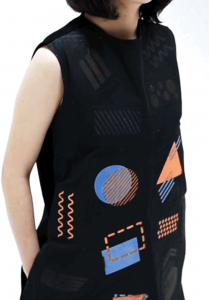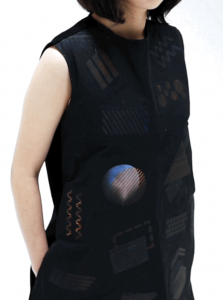Inspired by ‘mirror mirror on the wall’
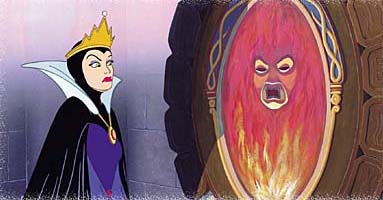
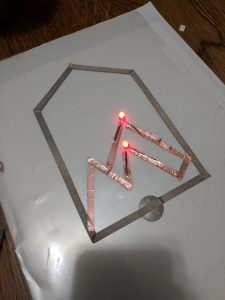
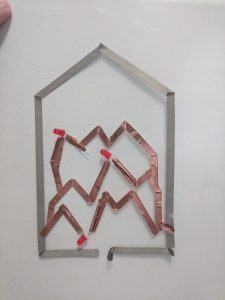
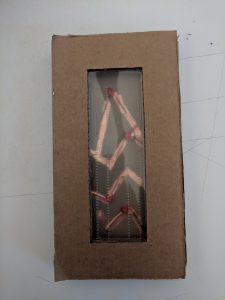
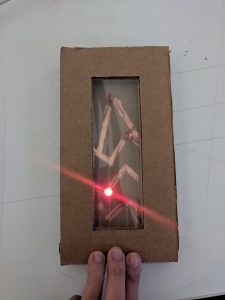
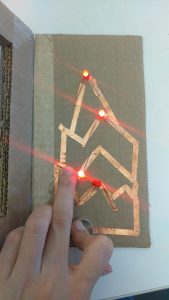
Inspired by ‘mirror mirror on the wall’






This is actually 2nd week’s homework. (Creating a path illustration)
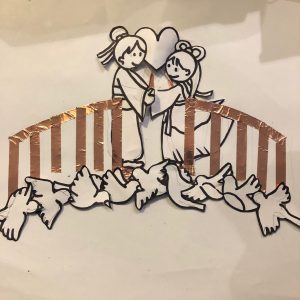
I created illustration with conductive tape ( the bridge ).
This is a scene is from Korean traditional story “kyun-woo and Jik-nyu”.
When their hands are touched(pushed) LED light behind the heart will glow!
This is an Interactive Light Painting that was done by Jie Qi which when you blow on the white puffs, the seeds will grow and generate into new flowers. This is done by using LEDs, microcontrollers, and copper tape. I love how this project seems so clean and beautiful but requires such complexity into the circuits behinds the painting. And I also wonder what they used to sense the users’ breaths to trigger the seed’s growth. I’m intrigued by how you can make a simple painting like this and change it to a painting with this many dimensions. It becomes a fun piece to interact with!
Detailed Project Details can be found on her blog here.
In this video, they used painting as an interface to play a music. This is fascinating because you can now have more sense to play with. Normally, we just use one sense to perceive. For Example, an eye to watch a painting. I’m really want to try to use as many senses we have in future projects to enhance interaction experience. If we can use visions, sounds, and scents, our experience with any interaction will increase and more memorable than the other medium.
You can narrate your story through painting and sounds which I love to experiment with.
Project By sab

This is a project developed by the Self-Assembly Lab, a group of MIT researchers interested in exploring the properties and possibilities of programmable and smart material, as well as soft robotics, with the goal of re-inventing the way artifacts are manufactured today.
Although the material presented in this example requires a specialized process that is not yet available for market access; It can give us a glimpse of what the field of programmable materials with different properties, can provide us for future applications.
In this project in specific, the Self-Assembly Lab explores the properties of elastic materials (printed in 3D as silicone or rubber) with pneumatic (inflatable) abilities as a catalyst for the creation of new forms, postures and experiences: “4D structures that adapted according to function, performance and aesthetics.”
Self-Assembly Lab partnered with BMW to look for innovative solutions to apply in car interiors that can mutate and transform according to the specific needs of the user. The results in research in this field, can open new possibilities in other areas such as: architecture, aerospace, adaptive products, appareal, etc…
Self-Assembly Lab Team: Bjorn Sparrman, Shokofeh Darbari, Rami Rustom, Maggie Hughes, Schendy Kernizan, Jared Laucks, Skylar Tibbits
BMW Team: Sophie Richter, Akos Stegmar
I recently saw (and touched and heard) Tactile Orchestra at Cooper Hewitt’s “The Senses: Design Beyond Vision” exhibition. The installation is a soft, furry wall that– when stroked– plays part of an orchestra. Depending on the exact movement and location of your touch, different parts of the orchestra play; the more people stroking the wall, the more sounds that are played.
I loved the childlike simplicity of the interface and the fact that it allowed multiple, simultaneous interactions: both humans-to-wall and humans-to-humans. I felt like a kindergartener, surrounded by other kindergarteners, with my arms stretched out experimenting, playing, and exploring.
I’m very intrigued by this interactive mural project because it preserved how graphically satisfying it is and then added interactivity based on that graphic design. In the project they applied soft conductive materials — conductive paint and copper tape. Then they connected different parts of the mural to an electronic board which would tell the projector to project different motion graphics onto the mural.
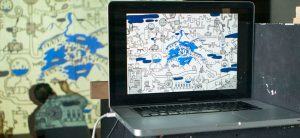
I am very drawn to the piece Contours by Alicja and Fabio. Installation art that uses technology but is not specifically screen based is what made me interested in attending DT in the first place! The ability of technology to be incorporated into the physical environment is, for lack of a more erudite word, MAGICAL. Technology can make something as intimidating as installation art into a much more friendly experience because the viewer is able to physically interact with the piece rather than remaining passive. Installations that are interactive have the potential to be a gateway to a greater appreciation of art for people who are ordinarily intimidated by it.
Below is a video of Contours in action. Enjoy.
This project is part of a textile design students at MOME – Moholy-Nagy University of Art and Design performed by EjTech. It consists of different systems compound by sensors that play music/sound. The uniqueness of this project relies on its materiality, all natural materials, fibers, leaves, and some other elements that make this technological project break the barrier between nature and technology. I find it both poetic and visually compelling.
There is a wide variety of hand-crafted sensors made of textile in addition to different natural materials coming from different plants and vegetables. Of course, I couldn’t try it and feel it, but it seems to me that it has to be really smooth and satisfying. I love every bit of this project! I’d like to try to work with natural materials combined with other synthetics that makes the interaction viable, efficient and reliable. It’s highly experimental, but I’m willing to explore new ways to play with senses and haptics.
Artists and designers have been proposing the ideas to grow textiles as the ways to think about environmental, sustainable, ethical issues surrounding the textile production.
We propose to think about these issues including how e-textiles and smart textiles plays a role towards sustainable living, creating possible futures for second skins, sensors and adaptive/responsive structures. EjTech.
This project is from a guest lecturer I got to know from last semester. The project is a IOT dress that visualizes the user’s daily interactions and diary entries. The diary entry is analyzed by the server through keyword tags, then the matching thermochromic paint pattern will show up on the dress. I liked the personal and abstract aspects of this project, but I was more intrigued by the tech elements of this dress. It involves elements like Bluetooth LE module, phone app, cloud server, embedded heat packs, and thermochromic paints. I am really excited for the thermochromic paints class!
